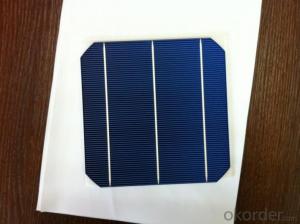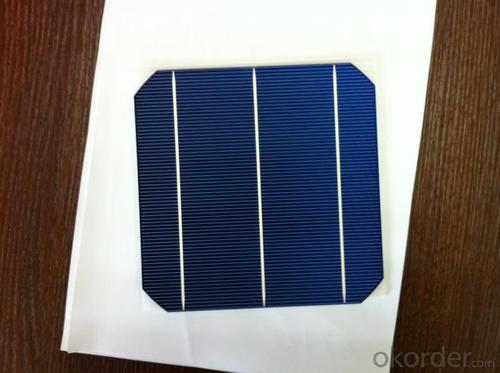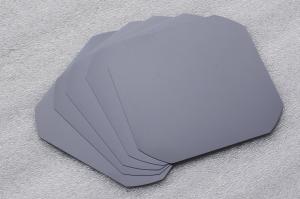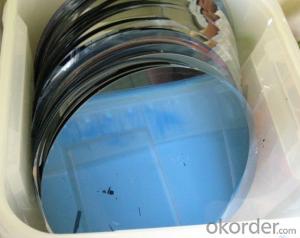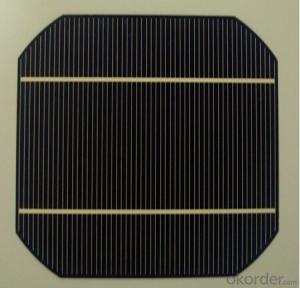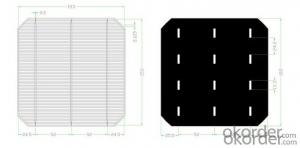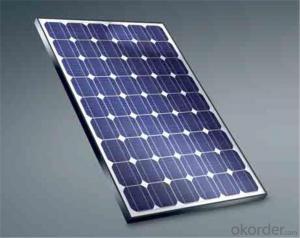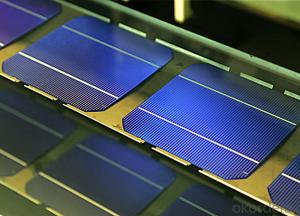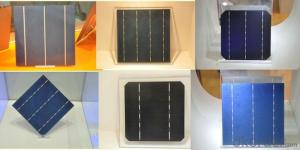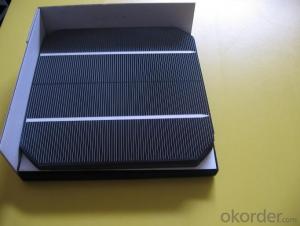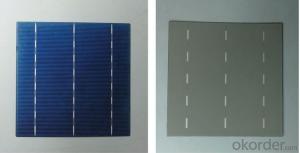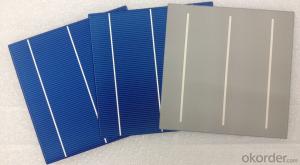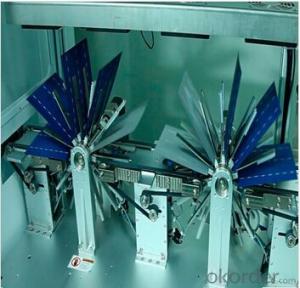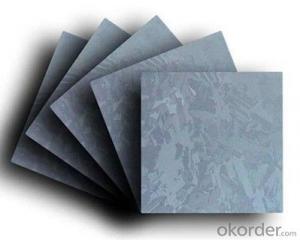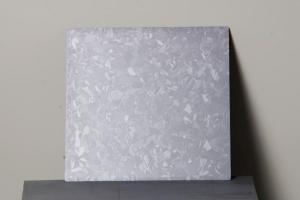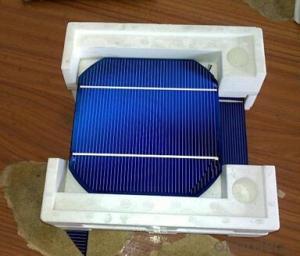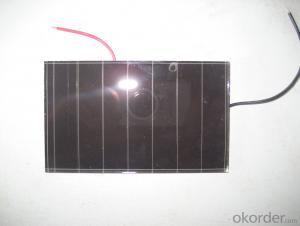Multicrystalline Silicon Solar Wafer - High Quality A Grade Poly/Monocrystalline 5V Solar Cell
- Loading Port:
- Shanghai
- Payment Terms:
- TT OR LC
- Min Order Qty:
- 1000 pc
- Supply Capability:
- 100000 pc/month
OKorder Service Pledge
OKorder Financial Service
You Might Also Like
Specifications
hot sale solar cell
1.16.8%~18.25% high efficiency
2.100% checked quality
3.ISO9001/ISO14001/TUV/CE/UL
4.stable performance
We can offer you the best quality products and services, don't miss !
POLY6'(156*156)
Polycrystalline Silicon Solar cell
Physical Characteristics
Dimension: 156mm×156mm±0.5mm
Diagonal: 220mm±0.5mm
Thickness(Si): 200±20 μm
Front(-) Back(+)
Blue anti-reflecting coating (silicon nitride); Aluminum back surface field;
1.5mm wide bus bars; 2.0mm wide soldering pads;
Distance between bus bars: 51mm . Distance between bus bars :51mm .
Electrical Characteristics
Efficiency(%) | 18.00 | 17.80 | 17.60 | 17.40 | 17.20 | 16.80 | 16.60 | 16.40 | 16.20 | 16.00 | 15.80 | 15.60 |
Pmpp(W) | 4.33 | 4.29 | 4.24 | 4.19 | 4.14 | 4.09 | 4.04 | 3.99 | 3.94 | 3.90 | 3.86 | 3.82 |
Umpp(V) | 0.530 | 0.527 | 0.524 | 0.521 | 0.518 | 0.516 | 0.514 | 0.511 | 0.509 | 0.506 | 0.503 | 0.501 |
Impp(A) | 8.159 | 8.126 | 8.081 | 8.035 | 7.990 | 7.938 | 7.876 | 7.813 | 7.754 | 7.698 | 7.642 | 7.586 |
Uoc(V) | 0.633 | 0.631 | 0.628 | 0.625 | 0.623 | 0.620 | 0.618 | 0.617 | 0.615 | 0.613 | 0.611 | 0.609 |
Isc(A) | 8.709 | 8.677 | 8.629 | 8.578 | 8.531 | 8.478 | 8.419 | 8.356 | 8.289 | 8.220 | 8.151 | 8.083 |
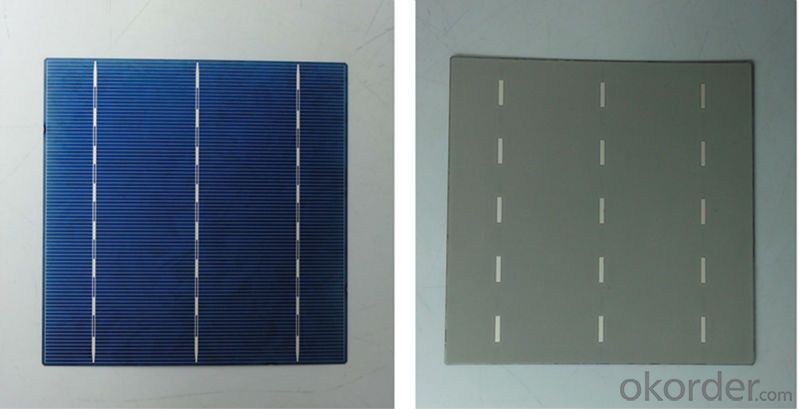
MONO5'(125*125mm)165
Monocrystalline silicon solar cell
Physical Characteristics
Dimension: 125mm×125mm±0.5mm
Diagonal: 165mm±0.5mm
Thickness(Si): 200±20 μm
Front(-) Back(+)
Blue anti-reflecting coating(silicon nitride); Aluminum back surface field;
1.6mmwide bus bars; 2.5mm wide soldering pads;
Distance between bus bars: 61mm . Distance between bus bars :61mm .
Electrical Characteristics
Efficiency(%) | 19.40 | 19.20 | 19.00 | 18.80 | 18.60 | 18.40 | 18.20 | 18.00 | 17.80 | 17.60 | 17.40 | 17.20 |
Pmpp(W) | 2.97 | 2.94 | 2.91 | 2.88 | 2.85 | 2.82 | 2.79 | 2.76 | 2.73 | 2.70 | 2.67 | 2.62 |
Umpp(V) | 0.537 | 0.535 | 0.533 | 0.531 | 0.527 | 0.524 | 0.521 | 0.518 | 0.516 | 0.515 | 0.513 | 0.509 |
Impp(A) | 5.531 | 5.495 | 5.460 | 5.424 | 5.408 | 5.382 | 5.355 | 5.328 | 5.291 | 5.243 | 5.195 | 4.147 |
Uoc(V) | 0.637 | 0.637 | 0.636 | 0.635 | 0.633 | 0.630 | 0.629 | 0.629 | 0.628 | 0.626 | 0.626 | 0.625 |
Isc(A) | 5.888 | 5.876 | 5.862 | 5.848 | 5.839 | 5.826 | 5.809 | 5.791 | 5.779 | 5.756 | 5.293 | 5.144 |

FAQ:
Q:How can i get some sample?
A:Yes , if you want order ,sample is not a problem.
Q:How about your solar panel efficency?
A: Our product efficency around 17.25%~18.25%.
Q:What’s the certificate you have got?
A: we have overall product certificate of ISO9001/ISO14001/CE/TUV/UL
- Q: Can solar silicon wafers be used in hybrid solar cell technologies?
- Yes, solar silicon wafers can be used in hybrid solar cell technologies. Hybrid solar cells combine different types of materials to optimize efficiency and performance. By incorporating silicon wafers along with other materials like organic polymers or perovskites, hybrid solar cells can harness a broader range of the solar spectrum and improve overall energy conversion.
- Q: How do solar silicon wafers perform in extreme weather conditions?
- Solar silicon wafers are designed to withstand extreme weather conditions effectively. They are typically made from durable materials that can handle temperature variations, such as high heat or freezing cold. Additionally, they are designed to be resistant to moisture, wind, and hail, ensuring their performance remains stable even during storms or extreme weather events. However, it is important to note that extreme weather conditions can still have some impact on the overall efficiency of solar panels, reducing their energy production temporarily.
- Q: What can be used to adjust its viscosity
- Polyethylene glycol and water soluble, I believe this may help you solve the problem
- Q: What are the different types of junction box sealants used on solar silicon wafers?
- There are primarily two types of junction box sealants used on solar silicon wafers - silicone-based sealants and hot melt adhesives. Silicone-based sealants offer excellent resistance to moisture, UV radiation, and temperature variations, making them ideal for outdoor solar applications. Hot melt adhesives, on the other hand, provide strong bonding properties and are relatively easier to apply during the manufacturing process. Ultimately, the choice of sealant depends on the specific requirements and conditions of the solar panel installation.
- Q: Can solar silicon wafers be used in solar-powered wearable devices?
- Yes, solar silicon wafers can be used in solar-powered wearable devices. The wafers can be integrated into the design of wearable devices such as smartwatches, fitness trackers, or even clothing, to harness sunlight and convert it into electrical energy to power the device.
- Q: How are solar silicon wafers protected from electrical surges?
- Solar silicon wafers are protected from electrical surges through the use of protective devices such as surge suppressors and transient voltage suppressors. These devices are installed in the solar power system to divert excess voltage and current away from the wafers, preventing damage to the delicate electronic components.
- Q: Can solar silicon wafers be used in urban environments for power generation?
- Yes, solar silicon wafers can definitely be used in urban environments for power generation. The compact size and versatility of solar panels allow them to be easily installed on rooftops, buildings, or even integrated into urban infrastructure such as streetlights or bus stops. This enables urban areas to harness solar energy and generate clean and renewable power in a sustainable manner.
- Q: How do solar silicon wafers perform in high-salt environments?
- Solar silicon wafers typically perform well in high-salt environments due to their inherent corrosion resistance. The silicon material used in solar cells is generally resistant to the corrosive effects of saltwater, making it suitable for installations near coastal areas or other high-salt environments. However, it is important to note that other components of the solar panel, such as the frame and electrical connections, may still be susceptible to corrosion and require proper protection measures.
- Q: How do solar silicon wafers contribute to the overall weight of a solar panel?
- Solar silicon wafers contribute significantly to the overall weight of a solar panel. These wafers are made of highly purified silicon and are the primary component responsible for converting sunlight into electricity. Since solar panels require multiple layers of these wafers to maximize energy production, the accumulated weight of these layers adds to the overall weight of the panel. Additionally, the supporting material, such as the glass cover and metal frame, also contribute to the weight. Therefore, solar silicon wafers play a crucial role in determining the weight of a solar panel.
- Q: Can solar silicon wafers be used in solar-powered street lighting?
- Yes, solar silicon wafers can be used in solar-powered street lighting. These wafers are commonly used in solar cells, which convert sunlight into electricity. Solar-powered street lights typically have solar panels made of silicon wafers that capture sunlight and convert it into electrical energy to power the lights.
Send your message to us
Multicrystalline Silicon Solar Wafer - High Quality A Grade Poly/Monocrystalline 5V Solar Cell
- Loading Port:
- Shanghai
- Payment Terms:
- TT OR LC
- Min Order Qty:
- 1000 pc
- Supply Capability:
- 100000 pc/month
OKorder Service Pledge
OKorder Financial Service
Similar products
Hot products
Hot Searches
Related keywords
